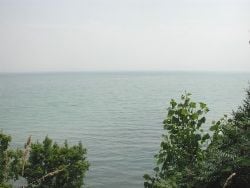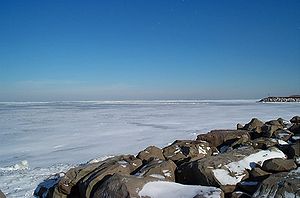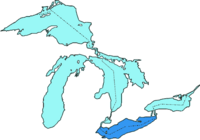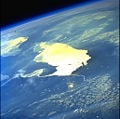Lake Erie
| Lake Erie | |
|---|---|
| Coordinates | |
| Primary sources | Detroit River |
| Primary outflows | Niagara River |
| Basin countries | Canada, United States |
| Max length | 388 km |
| Max width | 92 km |
| Surface area | 9,940 square miles (25,745 km²)[1] |
| Average depth | 19 m |
| Max depth | 210 ft (64 m)[1] |
| Water volume | 484 km³ |
| Residence time (of lake water) | 2.6 yrs |
| Shore length1 | 4385 km |
| Surface elevation | 571 ft (174 m)[1] |
| Islands | 24+ (see list) |
| Settlements | Buffalo, New York Erie, Pennsylvania Toledo, Ohio Monroe, Michigan Cleveland, Ohio |
| 1 Shore length is an imprecise measure which may not be standardized for this article. | |
Lake Erie (pronounced [ˈi.ɹi]) is the tenth largest lake on Earth[2] and, of the five Great Lakes of North America, it is the fourth largest by surface area, the southernmost, shallowest, and smallest by volume.[3][4] It is bounded on the north by the Canadian province of Ontario, on the south by the U.S. states of Ohio, Pennsylvania, and New York, and on the west by the state of Michigan. The lake is named after the Erie tribe of Native Americans who lived along its southern shore before being exterminated for aiding the Hurons, the enemy of the Iroquois League.[3]
The lake creates a favorable environment for agricultural pursuits in the bordering areas of Ontario, Ohio, Pennsylvania, and New York. In addition, its waters are home to numerous fish species, making it a popular site for commercial fishing. However, since high levels of pollution were discovered in the 1960s and 1970s, there has been continued debate over the extent of commercial fishing and measures used to protect the lake.
Geography
Lake Erie (42°30'N, 81°00'W) has a mean elevation of 571 feet (174 m)[1] above sea level. It has a surface area of 9,940 square miles (25,745 km²)[1] with a length of 241 miles (388 km) and breadth of 57 miles (92 km) at its widest points.
It is the shallowest of the Great Lakes with an average depth is 62 feet (19 m) and with a maximum depth of 210 feet (64 m).[1] The western section, comprising one-fourth of the area, is shallower with an average depth of 42 feet (13 m) and a maximum depth of 62 feet (19 m).[citation needed]
For comparison, Lake Superior has an average depth of 483 feet (147 m), a volume of 2,900 cubic miles (12,100 km³) and shoreline of 2,726 miles (4385 km).[citation needed]
Lake Erie is primarily fed by the Detroit River (from Lake Huron and Lake St. Clair) and drains via the Niagara River and Niagara Falls into Lake Ontario. Navigation downstream is provided by the Welland Canal, part of the Saint Lawrence Seaway. Other major tributaries of Lake Erie include the Grand River, the River Raisin, the Huron River, the Maumee River, the Sandusky River and the Cuyahoga River.
The American states Ohio, Pennsylvania and New York are located to the south of Lake Erie; Michigan lies to the west, and the Canadian province of Ontario lies to the north. Point Pelee National Park, the southernmost point of the Canadian mainland, is located on a peninsula extending into the lake. Several islands are found in the western end of the lake; these belong to Ohio except for Pelee Island and 8 neighboring islands, which are part of Ontario.
The cities of Buffalo, New York; Erie, Pennsylvania; Toledo, Ohio; Port Stanley, Ontario; Monroe, Michigan; and Cleveland, Ohio are located on the shores of Lake Erie. It was the last of the Great Lakes discovered by the French explorers, who had followed rivers out of Lake Ontario and portaged into Lake Huron.
History
{{#invoke:Message box|ambox}}
Native American
Before European contact, there were several tribes which lived along the shores of Lake Erie. The Erie tribe (from whom the lake takes its name) lived along the southern edge while the Neutrals (also known as Attawandaron) lived along the northern shore. Both tribes were conquered and exterminated during the Beaver Wars in 1655 by the Iroquois confederacy.
For many years after that war, the land around Lake Erie remained uninhabited and was used by the Iroquois as a hunting ground, until the waning of the their power around 1700. About that time, several other Native American tribes moved into the empty land, namely the Ottawa, Ojibwe, Wyandot, and Mingo tribes.
European Exploration and Settlement
In 1669, the Frenchman Louis Jolliet was the first documented European to sight Lake Erie, although there is speculation that Etienne Brule may have come across it in 1615. Lake Erie was the last of the Great Lakes to be explored by Europeans, since the Iroquois who occupied the Niagra river area were in conflict with the French, and they did not allow explorers or traders to pass through.
Recent History
Lake Erie infamously became very polluted in the 1960s and 1970s. Urban legend has described it as a dead lake, but both sport and commercial fishing have continued without interruption to the present day. Pollution in the lake did not get much attention until the great Cuyahoga River Fire in June of 1969. Pollution from Cleveland and other Ohio cities had so contaminated this tributary of Lake Erie with petrochemicals that it actually caught on fire. The fire embarrassed state officials and prompted the U. S. Congress to pass the Clean Water Act.
Ecology
Like the other Great Lakes, Erie produces lake effect snow when the first cold winds of winter pass over the warm waters, leading to Buffalo, New York being the eleventh snowiest place in the entire United States.[5] The lake effect ends or its effect is reduced, however, when the lake freezes over. Being the shallowest of the Great Lakes, it is the most likely to freeze and frequently does.[6]
The lake is also responsible for microclimates that are important to agriculture. Along its north shore is one of the richest areas of Canada's fruit and vegetable production, and along the southeastern shore in Ohio, Pennsylvania, and New York is an important grape growing region, as are the islands in the lake.
During the 1960s and 1970s, Lake Erie experienced changes in water quality associated with increasing levels of the nutrient phosphorus in the water and bottom sediments. The result was eutrophication of the system which resulted in major changes in productivity and algal blooms. The decomposition of algae led to extensive seasonal anoxic areas in the lake (the so-called dead zone), that were expanding rapidly in the early 1970s. The decomposing algal masses and associated fish kills fouled shorelines, contributing to the widespread impression of Lake Erie as a dead lake.
A 1972 agreement between Canada and the United States reduced the dumping and runoff of phosphorus into the lake significantly. A dead zone persists in the central Lake Erie basin during the late summer. The U.S. Environmental Protection Agency is currently studying this cyclic phenomenon.[7]
Since the 1970s environmental regulation has led to a great increase in water quality and the return of economically important fish species such as walleye and other biological life.[8]
However, the lake ecosystem is much changed from its original state, with a long list of invasive species well established. Common fish species such as rainbow smelt, alewife, white perch and common carp have all been introduced from outside the Great Lakes. Non-native sportfish such as rainbow trout and brown trout continue to be stocked for anglers to catch. Attempts to stock the lake with Coho Salmon were made, but failed, and that species is once again nearly absent from the lake. Recent invaders, zebra and quagga mussels have populated the entire Lake Erie ecosystem, altering energy flow through the food web away from the pelagic zone and into the benthic zone.
Other invasive species, such as the goby (recently arrived) and the grass carp (on the doorstep), have increased public debate about the risks of non-native invaders to Great Lakes ecosystems.
The effects of zebra mussels and gobies have been credited with the increased population and size of smallmouth bass in Lake Erie.[9]
Lake Erie is home to one of the world's largest freshwater commercial fisheries. Once a mainstay of communities around the lake, commercial fishing is now predominantly based in Canadian communities, with a much smaller fishery, largely restricted to yellow perch, in Ohio. The Ontario fishery is one of the most intensively managed in the world. It was one of the first fisheries in the world managed on individual transferable quotas (ITQs) and features mandatory daily catch reporting and intensive auditing of the catch reporting system. Still, the commercial fishery is the target of critics who would like to see the lake managed for the exclusive benefit of sport fishing and the various industries serving the sport fishery.
Commercial landings are dominated by yellow perch and walleye, with substantial quantities of rainbow smelt and white bass also taken. Anglers target walleye and yellow perch, with some effort directed on rainbow trout. A variety of other species are taken in smaller quantities by both commercial and sport fleets.
Although management of the fishery is by consensus of all management agencies with an interest in the resource (the states of New York, Pennsylvania, Ohio and Michigan and the province of Ontario) under the mandate of the Great Lakes Fishery Commission, and driven by comprehensive fisheries assessment programs and sophisticated mathematical modeling systems, it remains the source of considerable recrimination, primarily from United States based angler and charter fishing groups with an historical antipathy to the commercial fishery. This conflict is complex, dating from the 1960s and changes in U.S. fisheries management that led to elimination of commercial fishing in most U.S. Great Lakes states. The process began in the state of Michigan, and its evolution is well documented in Szylvian (2004)[10], using Lake Michigan as a case study. The underlying issues are universal, wherever sport and commercial fishing coexist, but their persistence in the Lake Erie context, one of the most intensively scrutinized and managed fisheries anywhere, suggests that these conflicts are cultural, not scientific, and therefore not resolvable by reference to ecological data. These debates are largely driven by social, political and economic issues, not ecology[11].
Geology
Lake Erie has a lake retention time of 2.6 years, which is the shortest of all the Great Lakes.[12]
Like the rest of the Great Lakes, Erie's levels fluctuate with the season of the year, with the lowest levels in January and February, and the highest in June or July. Its average yearly levels also vary depending on long-term precipitation variations, with levels falling during droughts and rising during periods of extended above-average precipitation.
Lake Erie's short-term level changes are often subject to weather, since its shallowness and the southwest-to-northeast alignment of its longitudinal axis make it particularly prone to seiches, especially during high southwesterly winds, when the lake water tends to pile up at one end of the lake. This can lead to large storm surges, potentially causing damage onshore. During one storm in November 2003, the water level at Buffalo rose by 7 feet (2.1 m) with waves of 10-15 feet (3-4.5 m) on top of that, for a cumulative rise of as much as 22 feet (6.7 m). Meanwhile, Toledo at the western end of the lake will measure similar drops in water level. After the storm event, the water will slowly slosh back and forth, similar to the effect in a bath tub, until equilibrium is re-established.
Islands
- Big Chicken Island
- Chick Island
- East Sister Island
- Gibraltar Island
- Green Island
- Gull Island
- Hen Island
- Johnson's Island
- Kelleys Island
- Little Chicken Island
- Lost Ballast Island
- Middle Island
- Middle Bass Island
- Middle Sister Island
- Mouse Island
- North Bass Island
- North Harbour Island
- Pelee Island
- Rattlesnake Island
- South Bass Island
- Starve Island
- Sugar Island
- Turtle Island
- West Sister Island
See also
- List of world's largest lakes
- Cedar Point
- Bass Islands
- Erie Canal
- Welland Canal
- Maumee Bay
- Bessie the Lake Erie sea monster
- Great Lakes Areas of Concern
ReferencesISBN links support NWE through referral fees
- ↑ 1.0 1.1 1.2 1.3 1.4 1.5 Wright, John W. (ed.) and Editors and reporters of The New York Times (2006). The New York Times Almanac, 2007, New York, New York: Penguin Books, 64. ISBN 0-14-303820-6.
- ↑ Large Lakes of the World. Factmonster.com.
- ↑ 3.0 3.1 Lake Erie - Facts and Figures. Great Lakes Information Network.
- ↑ Erie, Lake. Factmonster.com.
- ↑ Answers: 10 snowiest 'cities' aren't all in New York. Chris Cappella, USATODAY.com.
- ↑ What's the physics behind "lake effect snow"?. the Straight Dope Science Advisory Board.
- ↑ Lake Erie 'Dead Zone'. US EPA Lake Erie 'Dead Zone'. URL accessed on December 15, 2005.
- ↑ Recovery of Lake Erie Walleye a Success Story. Michigan Department of Natural Resources.
- ↑ [1]
- ↑ Szylvian,K.M. 2004. Transforming Lake Michigan into the 'World's Greatest Fishing Hole': The Environmental Politics of Michigan's Great Lakes Sport Fishing, 1965–1985.
- ↑ Berkes, F. 1984. Competition between commercial and sport fishermen: an ecological analysis. Human Ecology 12: 413-429.
- ↑ Great Lakes; Basic Information: Lake Erie. U.S. Environmental Protection Agency.
Images
- Pbalson 20060527 IMG 3822.JPG
Sunset over Lake Erie near Cleveland, Ohio
- Pbalson 20060527 IMG 3835.JPG
Sunset over Lake Erie near Cleveland, Ohio
External links
| North American Great Lakes |
| Lake Superior | Lake Michigan | Lake Huron | Lake Erie | Lake Ontario |
Credits
New World Encyclopedia writers and editors rewrote and completed the Wikipedia article in accordance with New World Encyclopedia standards. This article abides by terms of the Creative Commons CC-by-sa 3.0 License (CC-by-sa), which may be used and disseminated with proper attribution. Credit is due under the terms of this license that can reference both the New World Encyclopedia contributors and the selfless volunteer contributors of the Wikimedia Foundation. To cite this article click here for a list of acceptable citing formats.The history of earlier contributions by wikipedians is accessible to researchers here:
The history of this article since it was imported to New World Encyclopedia:
Note: Some restrictions may apply to use of individual images which are separately licensed.









